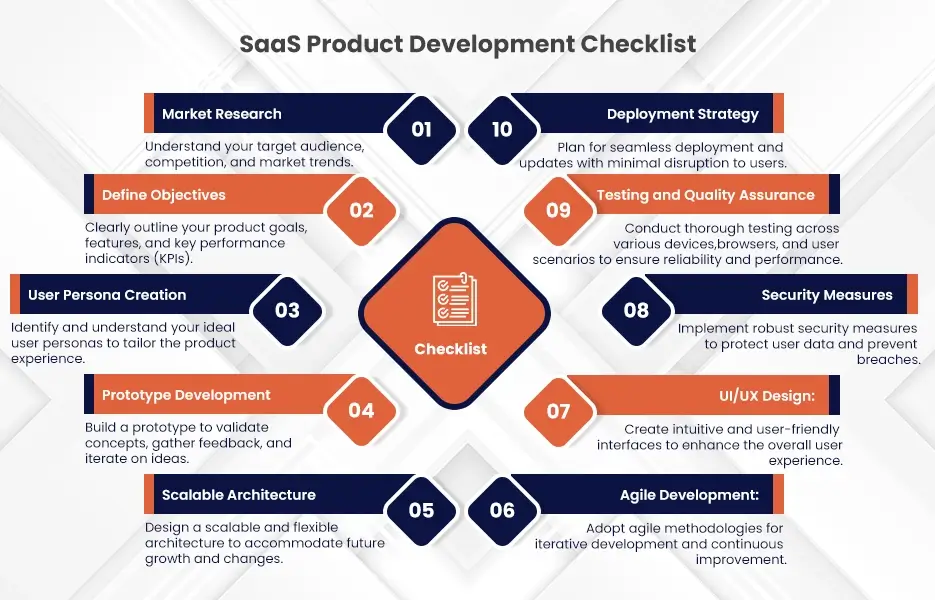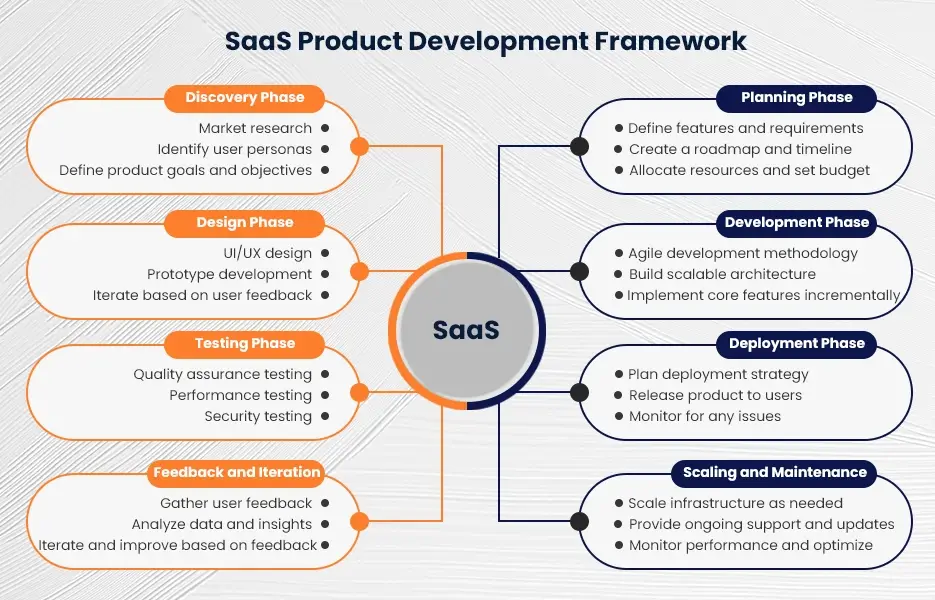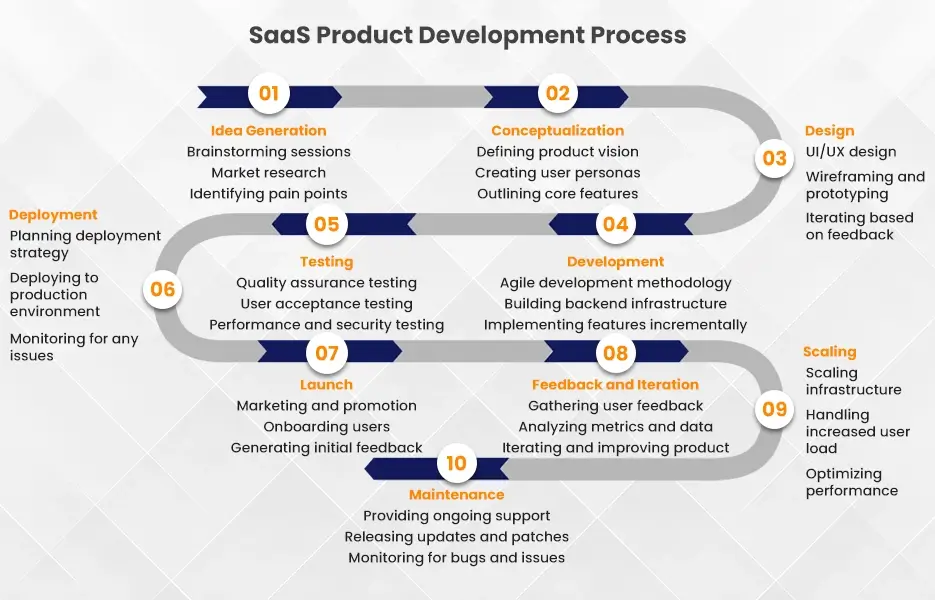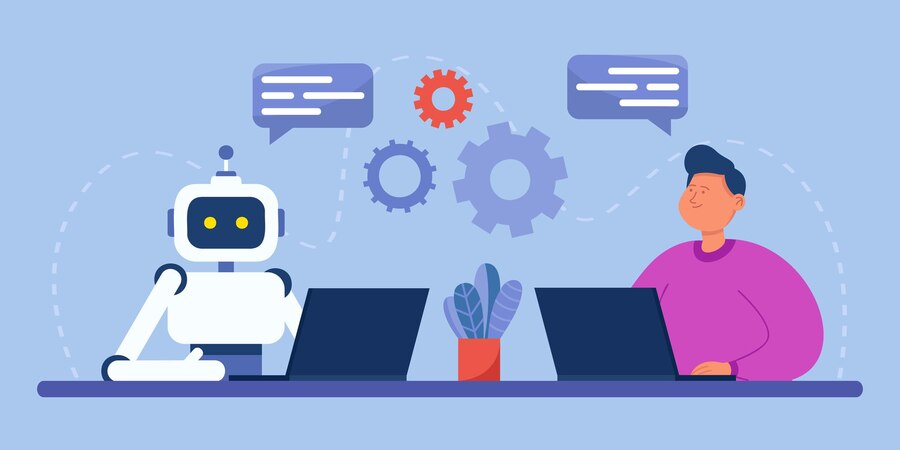Table of Contents
Software as a Service or SaaS is a way of conveying applications over the Web – as a service. Also known as cloud software, ASP, on-demand software or facilitated software. The main applications for buyers were things like webmail. In business, things like enlistment, costs and client relationship management were among the early innovations. SaaS product development has since turned into a generally utilized business model with an ever-increasing number of various types of applications available via the cloud.
So what’s been the driver for businesses to look for cloud solutions? One attraction was how fast they could get services up and working. Compared with complex in-house IT projects with long lead times, SaaS implementation is fast and easy. Harvard Business Review detailed that the head of marketing at a major Visa company was “super excited when told it would take just five weeks to get a cloud application running. IT had originally cited a year and a half.” The US SaaS industry is set to grow by over 2x by 2025. Furthermore, that is where this guide will become an integral factor.
It covers all that a business, startup, SME, or enterprise would need to be familiar with SaaS application development and entering the market. However, before we dive into the details of SaaS application development, how about we start with understanding what SaaS applications are?
Introduction to SaaS Applications
Software-as-a-service, or SaaS for short, is a cloud-based technique for giving software to users. SaaS product development companies buy into an application rather than purchasing it once and installing it. Clients can sign into and utilize a SaaS application from any compatible gadget over the Web. The actual application runs on cloud servers that may be far removed from a client’s location.
A SaaS application may be accessed through a browser or an app. Online email applications that clients access through a browser, for example, Gmail and Office 365, are normal examples of SaaS applications. The distinction between SaaS and a software installation on a client’s PC is somewhat similar to the contrast between streaming a TV show on the web and purchasing all the seasons of the TV show on DVD.
Take Gmail for instance. We as a whole use Gmail for sending and getting emails. Google has it. We, then again, essentially access it over the web on our programs. This is precisely how SaaS works. The SaaS application’s host or proprietor maintains the product while users pay to get it based on their use. In any case, when disconnected and on-premise software turned out only great for custom enterprise software development companies.
Transform Your Ideas into Reality and Get started on your SaaS product development journey today.
Top 5 Advantages of SaaS Product Development
SaaS provides a captivating option in contrast to standard software installation in the business climate (conventional model), where you need to construct the server, introduce the application, and configure it. All things being equal, the applications live on a remote cloud network through the web or an API, and it works like a rental. You and your association have the approval to be involved in it for a while and pay for the software that you are utilizing. Coming up next are five of the top benefits of utilizing SaaS:
1. It Reduces An Opportunity To Market
By using existing infrastructure and development frameworks, SaaS organizations can assist the development cycle, empowering them to deliver products quicker than traditional software development methods. This permits businesses to rapidly answer market requests, gain an upper hand, and begin producing income sooner. Furthermore, SaaS development products commonly offer easier scalability and accessibility, as they can be gotten to through the Web without the requirement for complex establishments or updates on users’ devices.
2. It Reduces The Costs
Contrasted with the conventional software model, users don’t have to purchase total software or its licenses. The multi-inhabitant solution of SaaS applications permits even independent companies to utilize the software at a lower cost.
3. It Gives Simple Integration and Scalability
Living in cloud conditions, it is in every case simple to scale and adaptable. You can switch the subscription model to upgrade the SaaS offering when expected to scale.
4. It is Consistently Ready With New Upgrades
The greatest aspect of adopting a SaaS product development service is that it is generally ready with new upgrades. Businesses can continuously depend on SaaS providers to send off new updates and stay up with the latest.
5. It Is Secure
SaaS providers generally ensure that the security is intensified to keep the data of businesses and users secure. You can check for security ensures, backups, and more while searching for the SaaS product.

Exploring Opportunities in the SaaS Product Development Ecosystem
End-user cloud SaaS expenditure is predicted to grow by almost $365 million in 2023. One of the critical drivers behind this growth in the SaaS industry was the developing dependence on computerized technologies or advanced dependence.
An extraordinary illustration of this would be the requirement for remote working tools in 2020. As the pandemic hit, businesses needed to depend on SaaS tools to convey, team up, and oversee work proficiently. What’s more, taking into account the desperation of the circumstance, the smartest option was to go for SaaS providers.
This developing inclination toward computerized products hasn’t ended and isn’t supposed to stop in the approaching quite a long while. In this way, SaaS based product development has plenty of opportunities in the SaaS industry.
#1. Taking Advantage of The AI/ML Potential
Artificial Intelligence and Machine Learning are the two popular expressions that have turned into a trend-main thrust in pretty much every industry. The SaaS industry is no exception. There is a great deal of undiscovered potential lying in the domain of Artificial Intelligence and Machine Learning. Custom software development companies in USA can investigate this area and assemble SaaS products that have highlights of AI and ML to make them tomorrow-evidence.
#2. Development With Cloud Growth
Cloud is offering endless potential outcomes to businesses of all verticals and scales. This is opening up a large number of roads for businesses. Priority Research has brought up that the worldwide cloud registering market is expected to develop at a CAGR of 17.32% and reach US$ 1,630 billion by 2030. Also, practically 55% of this income is created by SaaS products alone. Presently wonder SaaS is supposed to develop at a dramatic rate as the cloud registering market develops.
#3. Analytics-Centric SaaS Products
Data is extremely significant in the SaaS industry today and drives most of the trends. With significant businesses looking at advanced change, it is normal that analytics-centric SaaS products will begin to govern the market. There would be a flood of SaaS products that are imaginatively revolved around data and analytics. Developing a SaaS product would likewise help businesses in going with data-driven choices and choosing business intelligence.
#4. Center Around Improving Customer Experience
Improving the customer experience isn’t simply the center focal point of CXOs today. It is collecting consideration from CTOs, business visionaries, and every other person in the industry. Customer experience or CX enormously affects customer conduct, product growth, and achievement.
To further develop the customer experience, businesses would be expected to pursue the customer experience directions prevailing in the industry. These would incorporate frictionless recruits, customized experience, confinement, proactive help, and further developed commitment, and that’s just the beginning.
#5. Developing Inclination On Vertical SaaS
Being the most recent trend in the industry, Vertical SaaS makes certain to open up plenty of opportunities for SaaS providers. Not at all like even SaaS which targets customers and clients across all ventures and specialties, vertical SaaS centers around a specific vertical and meets their normal necessities.
These are savvy and industry-explicit answers for SaaS providers as well as their ideal interest groups. Vertical SaaS opens up new roads for customization and conveying better experiences. Aside from that, vertical SaaS empowers providers to gather industry-explicit customer data that can be utilized to convey keen arrangements. This has likewise opened opportunities for businesses to convey speciality products. These SaaS products can settle speciality industry challenges and pain focuses, in this way, likewise opening opportunities for more modest businesses planning to send off their SaaS product.
SaaS Product Development Obstacles and How To Overcome Them
Any flourishing industry will undoubtedly have its arrangement of challenges. At the point when your team is good to go to take on the SaaS development lifecycle or has already started one, there are a few barricades that they could need to overcome. We should view the normal challenges you could look at with your SaaS product development agency.
Challenge #1. Third-party Integration
One of the greatest challenges faced by businesses building their SaaS product is the need to incorporate them with third-party applications. The SaaS product ought to have the option to seamlessly speak with different applications and offer data. Types of Cloud Computing Solutions may very well be installment passages, CX platforms, contact databases, CRM, feedback tools, and email services, from there, the sky’s the limit. SaaS providers would either have to construct their custom integrations for their usefulness or make services or veneers to permit such integrations.
Challenge #2. Security and Protection of Data
Data is valuable and businesses need to ensure that the data taken care of in their SaaS product by the users is safeguarded no matter what. What’s more, taking into account the tremendous measure of data that SaaS products need to store, the protection and security of data turns into something like a challenge. There are different security chances related to SaaS products. These could be data spills, fraud, unapproved data access, phishing assaults, or account takeover.
While getting the SaaS application development, businesses ought to ensure that the database is distinct and GDPR consistent. Furthermore, SaaS providers ought to likewise ensure that they’ve received HIPAA compliance, SOX, PCI-DSS compliance, and more in light of their business model.
Challenge #3. Issue of Scalability and Future Updates
Businesses select SaaS as they need not stress over the tech refreshes from the frameworks’ end or getting the product refreshed for security patches and highlights, and that’s only the tip of the iceberg. Software Development Costs anticipate that it should be presented by the SaaS provider. Furthermore, it is the SaaS product proprietor or provider’s liability to continue refreshing the product and continue to scale the application as required.
SaaS providers can hold hands with a laid-out SaaS development organization and be guaranteed to get customary updates for technologies, and variants, and even send off new elements in light of the feedback gathered from the users.
Challenge #4. Dealing with the Lifecycle of Subscribers
SaaS providers additionally run over the challenge of dealing with the SaaS endorser’s lifecycle in light of their arrangements and subscriptions. Without legitimate SaaS lifecycle management, it would be trying for businesses to deal with the charging cycle.
They can either go with a third-party application to assist with dealing with the SaaS lifecycle of the users or have a team incorporate the usefulness into the SaaS product.
Challenge #5. Selecting Pricing and Delivery Model
Each business tries to have a successful monetization technique for its SaaS product. Furthermore, selecting the delivery and pricing model assumes a vital part in establishing that. This is a significant choice yet trying for most SaaS providers. They need to remember their interest groups to set the pricing and pick the model that would be the best fit to drive more subscriptions. Outsource SaaS product development very well may be a freemium, fixed expense, utilization-based, layered model, per-user-based, highlight-based, or more. In addition to that, you likewise need to characterize the monetization technique to create income from the product. Browse various methods of monetization like subscription, advertisement, Freemium, and so on.
While selecting the business model, you want to keep your product lifecycle or how it would be sent off, its contributions, software development costs, and the interest group as a primary concern.

Case Studies: Successful SaaS Product Development Examples
Most likely there are a few challenges confronting the SaaS industry. Be that as it may, numerous best custom software development companies have dealt with these challenges directly and overcome them with greatness. We should examine a portion of the top SaaS products that are administering different ventures today.
1. Communication
The pandemic constrained everybody to work in a good way, from the security of their homes. This additionally led to the remote working society. What’s more, that is precisely when the communication tools blast.
- Slack
Perhaps the earliest name that rings a bell when we consider communication tools is Slack. It is a one-stop instrument for all your communication necessities. From informing remote team individuals seamlessly and having a bunch of visits to making channels for various projects, and different things, this instrument has endless highlights. Identify Custom Software Needs might be coordinated effortlessly.
- Zoom
Another communication apparatus that has made life more However, during and after the pandemic is Zoom. Zoom increased market revenue by 5x between 2018 and 2024. This is one remotely coordinating SaaS instrument that empowers you to settle on video decisions, sound calls, share screens, and record gatherings.
2. Project Management
Overseeing projects has forever been a problem for businesses. One answer for such problems is utilizing project management tools. There are a few tools in the market today that make it more. However, for business proprietors to deal with their projects and monitor their advancement, particularly while working with dispersed teams or distant engineers. Here are the top project management tools in the market.
- Trello
Improving on a coordinated effort between teams, Trello is one of the most famous SaaS tools utilized by startups, independent ventures, and enormous-scope custom software development consulting. There are various elements like using time effectively with cards, drag-drop altering, adding labels and names, and sending alarms, and that’s only the tip of the iceberg.
- ProofHub
The most famous SaaS project management apparatus in the market right now is ProofHub. Cloud security is the fastest-growing segment in the IT security market and is known for empowering teams to run, track, and examine projects on a solitary stage. Highlights like workflows, project reports, quick project conversation, and so on, make this instrument significantly more remarkable.
3. Business
With regards to business, different tools empower seamless activities for a business cycle. There is one SaaS suite that empowers all business capabilities.
- Google Workspace
The most well-known SaaS device that offers a total set-up of tools for a wide range of business processes. No business on the planet could have possibly utilized any of the Google suites previously. Be it Gmail for sending emails or visiting, Google Docs for making documents and sharing, drive for putting away data on the web, Google Meets for web-based calling, or different applications of Google Workspace, there is a wide assortment of applications simplifying business tasks.
4. Sales, Marketing and CRM
The following most famous class for SaaS tools is Sales and Marketing. With the headway in marketing and sales robotization tools, numerous SaaS providers like many Custom Software Consulting Companies In USA have approached, offering their skills in various sorts of software.
- Hubspot
Beginning as an inbound marketing stage, Hubspot has now been able to turn into a main sales, marketing, and CRM device. It has an entire suite that offers all functionalities like CRM, CMS, lead age, constant analytics, Salesforce Integration, sales center, web-based entertainment integration and booking, and CRM, and the sky’s the limit from there. A full-growth software permits businesses to coordinate sales and marketing robotization with CRM and even characterizes life cycle stages for leads.
- Building SaaS Application
Now that you know the opportunities in the industry and the manners in which you can prevail with your SaaS product development, it’s time we get to its groundwork.
Best Practices To Build Successful SaaS Applications
Software architects are responsible for making imaginative items and advancing innovation costs. The kind of design you pick shows the amount of control you possess over information, framework, and customization choices. SaaS or Software-as-a-Service model is one of the significant architectures that empower you to give customer services anytime and anywhere. All in all, what are SaaS items, and for what reason are associations changing to them? What best practices could associations at any point take to be in this aggressive cloud world? There are various advances engaged with the whole SaaS development lifecycle. These mean flow in the accompanying request of stages:
Ready to Revolutionize Your Industry. Let’s innovate together with powerful SaaS product development.
1. The Planning Stage
The initial segment of building any new product is to design it out. This is where you get everything rolling with envisioning the product, ideating it, and carrying out groundwork around the equivalent. Here are the means to engage with it:
- Envision The Product
Research the opportunities around your thought and set up the extension for your product. This would incorporate everything according to the custom software development companies in USA viewpoint, the scale you need to take your product to, the objective market, the user persona, and the various renditions for SaaS product development you are planning to send off your product.
- Do Market and Competitor Research
Whenever you have envisioned your product or startup application, the subsequent stage is to act inside and out and research it. This incorporates researching your objective market, the crowd, and the competitors the same. This would assist with characterizing normal traits, selecting highlights that would reverberate best, and even evaluating the thought in light of the competitors.
2. The Selection Stage
The following stage in your SaaS product development lifecycle is to pursue the essential decisions that will decide the eventual fate of your product. These incorporate a ton of things like the development methodology you would follow, the technology frameworks you would utilize, the team that would construct the product, and in particular, the cloud provider where you would have your product. Here are the various selections you’d need to make:
- Technology Stack
The primary selection that you would need to make as far as the SaaS product development is to pick the technology stack. This is where you select the technologies that you would choose the frameworks for back-end, front-end, full-stack, and then some.
- Development Team
The following and most significant selection is your development team.1 in 5 companies’ SaaS spending was unaffected by the pandemic. They would be the ones making the essential design of your SaaS product as well as guaranteeing that it runs seamlessly with next to no mistakes. You can construct an in-house team for your SaaS product development or recruit far-off designers to fabricate disseminated teams.
3. The Development Stage
The following stage in building your SaaS product development is to get the ground working. With the bits of knowledge close by and every one of the basic decisions made, you want to begin building your product starting from the earliest stage. What’s more, that is likewise an exceptionally basic step that incorporates:
- Designing User Flow and Wireframing
Since we have the team and the fundamental thought ready. It’s time that we begin designing the user flow of the SaaS product development and making the wireframe. This is where you characterize the potential ways the user could take and their conceivable user travels, and make a user flow graph. This is how you will want to assemble the best plan for your product. A SaaS based product development company would have a progressive construction for your application alongside a visual portrayal of how your application would seem to be.
- MVP Development
With the wireframe and application’s visual data ready, you can begin building the model for your SaaS product. You can hold hands with an experienced firm to get MVP development. Custom software development outsourcing companies have a team of designers (both frontend and backend) to compose codes for your SaaS product. You pick the central element of your product and fabricate the model in light of it. This empowers you to send it off quicker, test it on your users, and evaluate the market interest. To fill in according to the feedback received, and even get market approval.

How To Select The Right SaaS Development Service Provider
SaaS application development is a tedious yet remunerating process. SaaS is considered the most important technology in business success. Furthermore, this is where holding hands with a SaaS product development partner can prove to be useful for you. There are a few justifications for why holding hands with a SaaS applications development organization might work out great for you. SaaS product development is an extended interaction that requires a ton of mastery and a range of abilities. Circumventing searching for abilities each time there is a prerequisite in your team. That can prompt a defer in the send-off or try to increment the general spending plan.
Also, you can essentially keep away from this multitude of issues by holding hands with an experienced SaaS product development organization. The US has over 6x more SaaS companies than any other country. You can rethink the development or even recruit far-off engineers or construct a team with them. Also, that is not all, there are a few different advantages of partnering up for your SaaS product:
- They can acquire long periods of experience and mastery
- You can increase your team or down unhindered
- Improving on the workflows in light of your prerequisites
- To be your specialists and assist you with scaling
- They have the experience and can construct quicker
Nonetheless while holding hands with a SaaS product development, there are a few things that you want to remember. Also, the principal thing is to follow the right interaction. There is a cycle with set advances that can help you.
Final Considerations on SaaS Product Development
Developing a SaaS product requires planning, diligent execution, and continuous improvement. By understanding the significance of SaaS in modern business, following the means engaged with SaaS product improvement, and monitoring the difficulties and tips for progress, you can make a great SaaS product that reverberates with customers and drives your business forward. Stay focused, adaptable, and customer-centric, and your SaaS product will be ready for outcome in the present serious scene. We made a valiant effort to give you exact, basic, and instructive rules — however, Custom Software Integration doesn’t fail to remember that this interaction will at last require a lot of imagination and spontaneous creation to succeed. Be available to novel thoughts, team joint effort, and challenges, and use them to fuel your SaaS product’s growth!
FAQs: Common Queries about SaaS Application Development
1. What is a SaaS?
Software as a service, or SaaS, alludes to a software delivery model in which projects are facilitated from a distance. That got to using an internet browser instead of downloading and introducing it locally.
2. How does SaaS Product Development Work?
SaaS product development is a model for conveying software using the cloud that gives end users admittance to preset projects in a good way. Customers might get the pre-introduced software from any gadget with a web association.
3. What is a SaaS Product Development Industry?
The business area involved by SaaS product development providers is at times called the “software as a service industry.” To address the issues of custom software development outsourcing of all sizes and ventures, a great many new and well-established SaaS providers are working nonstop to carry us into what’s in store.
4. What is a SaaS model?
What we currently allude to as “software as a service” (SaaS) is a worldview for dispersing and utilizing business software through the Web. At the point when an organization utilizes the SaaS (Software as a Service) model. It pays a service provider on a subscription reason for admittance to applications and other software facilitated in the cloud.
5. How does the SaaS Product Development model work?
The people who buy into the Software as a Service (SaaS) model compensate for the ordinary expense of utilizing authorized, off-site duplicates of different kinds of software. We acknowledge repeating customer installments for a service we give on a subscription premise (either month to month or yearly). The outcome of a software as a service (SaaS) business. Which depends on its capacity to stay in contact with and upsell to its ongoing customer base.
6. What is the service level agreement (SLA) for uptime?
However, the route to the SaaS provider’s service level agreement (SLA) is fundamental. Most SaaS providers should give uptime of something like 90% and give you sufficient notification of maintenance windows. To ensure a blackout doesn’t cause difficult issues, you ought to figure out what time region the framework will be in when it goes down for maintenance or upgrades.






